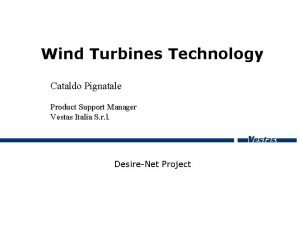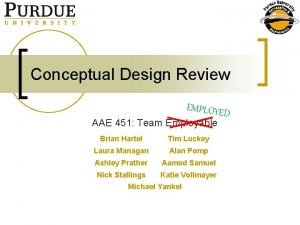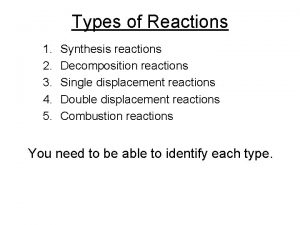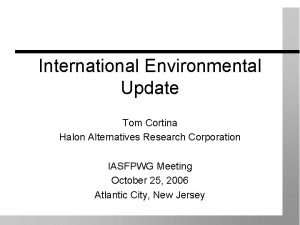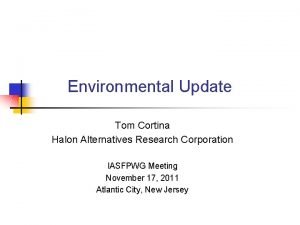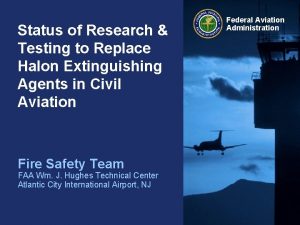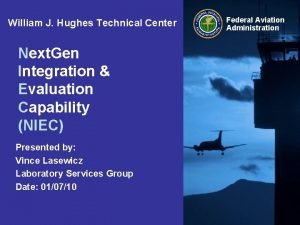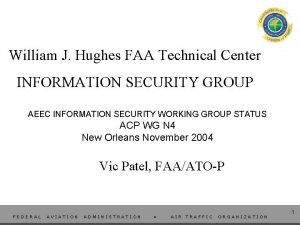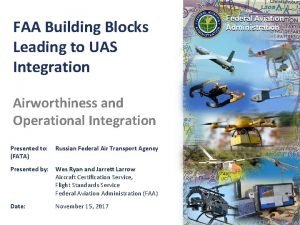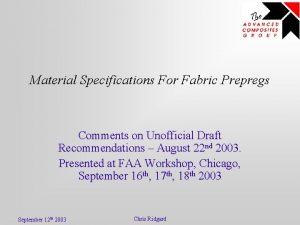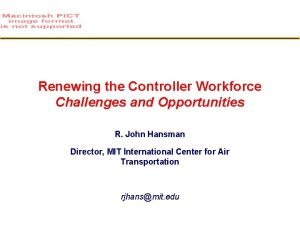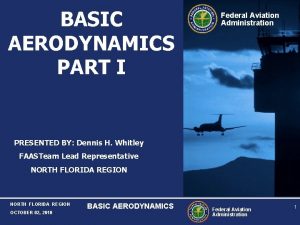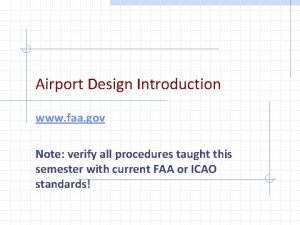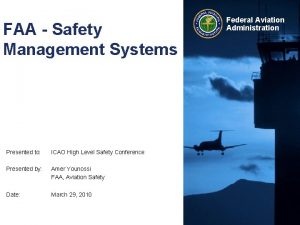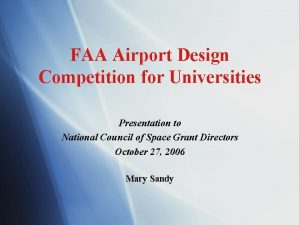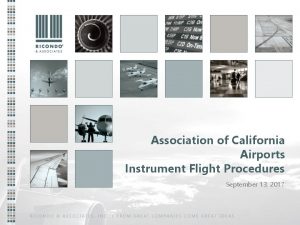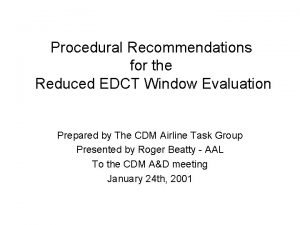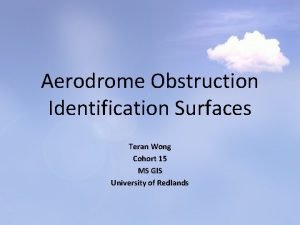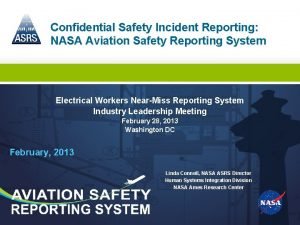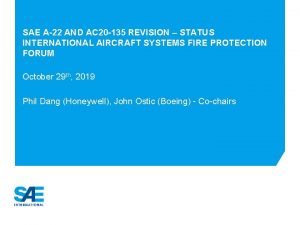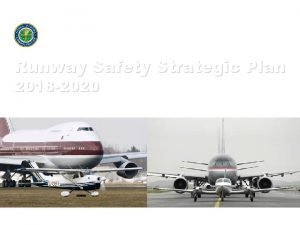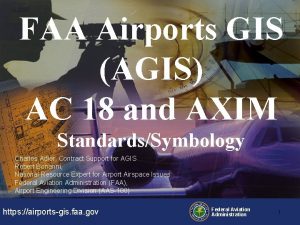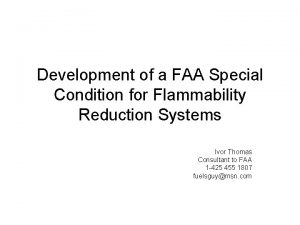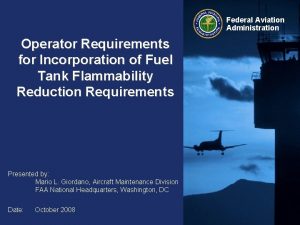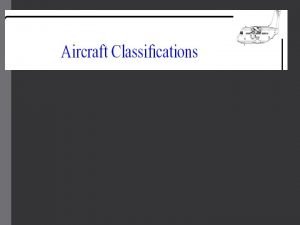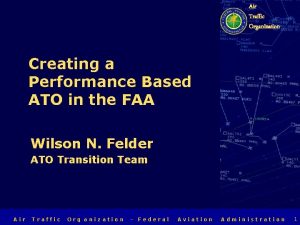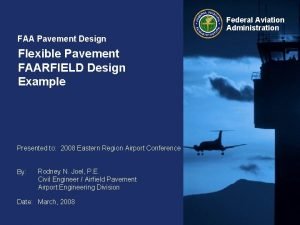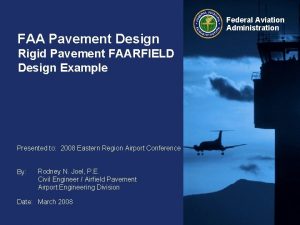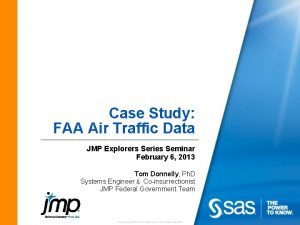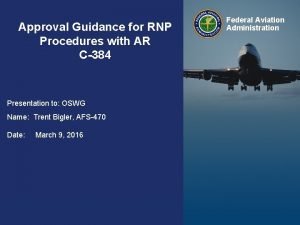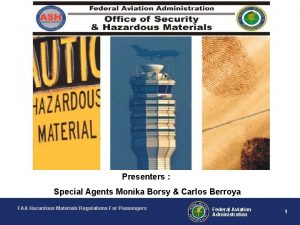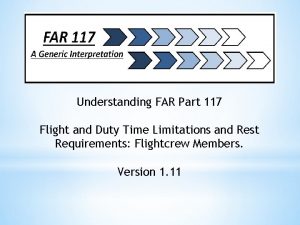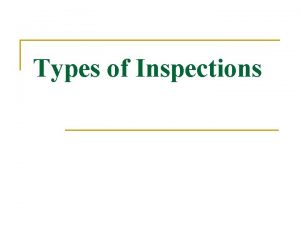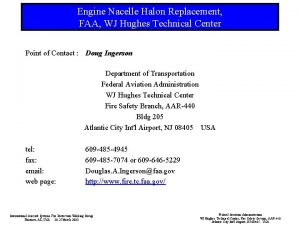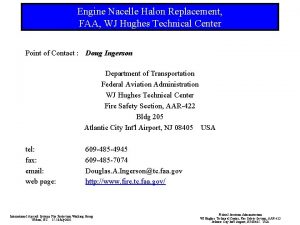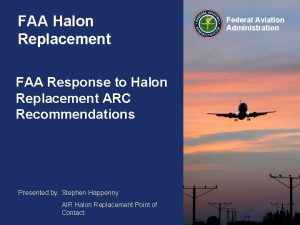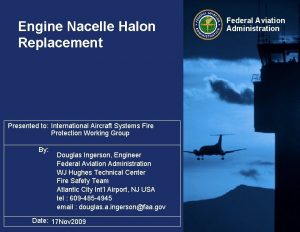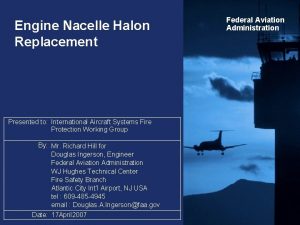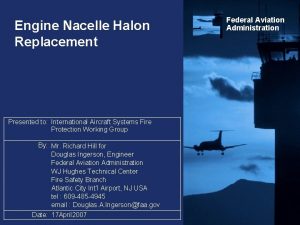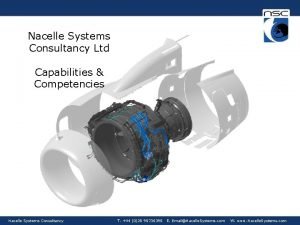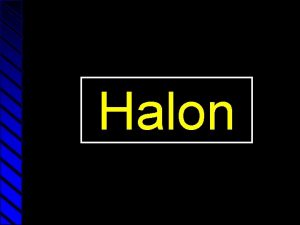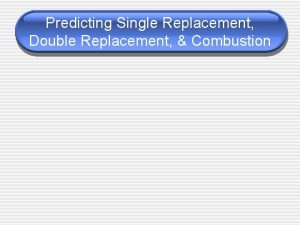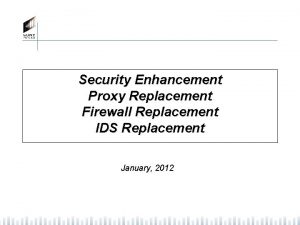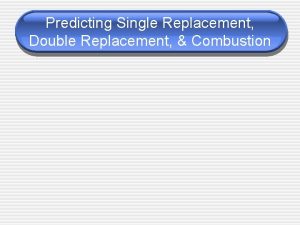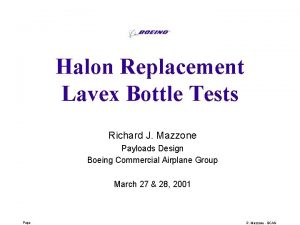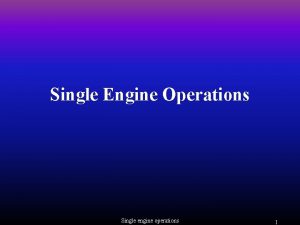Engine Nacelle Halon Replacement FAA WJ Hughes Technical



















































- Slides: 51

Engine Nacelle Halon Replacement, FAA, WJ Hughes Technical Center Point of Contact : Doug Ingerson Department of Transportation Federal Aviation Administration WJ Hughes Technical Center Fire Safety Section, AAR-422 Bldg 205 Atlantic City Int'l Airport, NJ 08405 USA tel: fax: email: web page: 609 -485 -4945 609 -485 -7074 Douglas. A. Ingerson@tc. faa. gov http: //www. fire. tc. faa. gov/ International Aircraft Systems Fire Protection Working Group London, England 13 -14 June 2002 Federal Aviation Administration WJ Hughes Technical Center, Fire Safety Section, AAR-440 Atlantic City Int'l Airport, NJ 08405 USA

Major Topics for Review : Project Progress Difficulties With Hot Surface Ignition Response To Hot Surface Ignition Difficulties Near Term Plans International Aircraft Systems Fire Protection Working Group London, England 13 -14 June 2002 Federal Aviation Administration WJ Hughes Technical Center, Fire Safety Section, AAR-440 Atlantic City Int'l Airport, NJ 08405 USA

PROJECT PROGRESS >April 1 ST, 2002 - Nacelle Fire Testing #Five tests run against established Halon distribution #Five tests resulted in complete extinguishment #Ran fuel/air mixture through test article looking for hot surface IGNITION after the successful five test sequence #Hot surface did not IGNITE mixture #Forward motion halted an investigation began >April 1 ST, 2002 - Test Conditions Air flow : 2. 2 lbm/s @ 100°F Fuel : JP 8, 0. 2 gpm @ 157 -160°F Agent : Halon 1301 @ 5. 2#, 100°F, 41 lbf/ft^3 Hot Surface Temperatures : Average of 4 thermocouples => 1065 - 1084°F Single point maximums = 1245 - 1283°F Preburn : 20 seconds International Aircraft Systems Fire Protection Working Group London, England 13 -14 June 2002 Federal Aviation Administration WJ Hughes Technical Center, Fire Safety Section, AAR-440 Atlantic City Int'l Airport, NJ 08405 USA

DIFFICULTIES WITH HOT SURFACE IGNITION Massive Hot Plate Geometry >Located at 12: 00 in the core beneath fuel spray >350 lb steel assembly >Electrically heated APPROXIMATE HOT PLATE THERMOCOUPLE POSITIONS FASTENING BOLTS International Aircraft Systems Fire Protection Working Group London, England 13 -14 June 2002 AIRFLOW Federal Aviation Administration WJ Hughes Technical Center, Fire Safety Section, AAR-440 Atlantic City Int'l Airport, NJ 08405 USA

DIFFICULTIES WITH HOT SURFACE IGNITION Reviewing Fire Test Requirements of the Minimum Performance Standard for the Engine and APU Compartments (MPSE) #Fire test requirements are a subset of the larger procedure #Run a minimum of five tests against the established Halon 1301 distribution #Demonstrate an extinguishment performance of 70 - 90% i Meaning that of 5 tests run, 4 result in complete extinguishment i The “failed” test requires that a hot surface IGNITE the fuel spray after the conditions of the initial flame extinguishment subside #Attain prescribed extinguishment performance by adjusting the fire intensity with the following parameters (in priority) : i Fuel flow rate i Hot surface temperature #Successful extinguishment is defined as an 8 second duration between initial flame extinguishment and the REIGNITION of the fire International Aircraft Systems Fire Protection Working Group London, England 13 -14 June 2002 Federal Aviation Administration WJ Hughes Technical Center, Fire Safety Section, AAR-440 Atlantic City Int'l Airport, NJ 08405 USA

RESPONSE TO HOT SURFACE IGNITION DIFFICULTIES Evaluating Non-existent Hot Surface Ignition #Reasoned two options as allowing inadequate hot surface IGNITION threat i Insufficient fuel flow rate i Insufficient hot surface temperature #Fuel flow Rate : Test fixture being run at highest desirable fuel flow rate i At 0. 2 gpm, liquid fuel observed to roll off core surfaces i Resultant test fire observed having a flame length of roughly 10 feet i Prior fires fueled at higher flow rates resulted in damage to the test section i Increasing fuel flow is deemed an undesirable option #Hot Surface Temperature : Only remaining remedy for existing geometry i Ran 15 tests with the existing massive hot plates, April 5 -15, 2002 i Tests configured to favor hot surface IGNITION International Aircraft Systems Fire Protection Working Group London, England 13 -14 June 2002 Federal Aviation Administration WJ Hughes Technical Center, Fire Safety Section, AAR-440 Atlantic City Int'l Airport, NJ 08405 USA

RESPONSE TO HOT SURFACE IGNITION DIFFICULTIES Massive Hot Plate Testing, April 5 -15, 2002 #Tests run to maximize hot surface ignition i no agent released ? removed agent cooling - although perceived as negligible against a massive hot plate ? removed agent interactions potentially retarding/complicating hot surface IGNITION behavior i fuel flow turned off for 8 seconds ? duration began when the agent was supposed to be released ? simulated the initial extinguishment by stopping fuel flow ? removed the cooling effects of the fuel on the massive hot plate - again perceived as negligible against a massive hot plate i fuel flow resumed at the expiration of the 8 seconds without electrical ignition while looking for hot surface IGNITION International Aircraft Systems Fire Protection Working Group London, England 13 -14 June 2002 Federal Aviation Administration WJ Hughes Technical Center, Fire Safety Section, AAR-440 Atlantic City Int'l Airport, NJ 08405 USA

RESPONSE TO HOT SURFACE IGNITION DIFFICULTIES Time Line for Massive Hot Plate Tests Investigating Hot Surface Ignition 30 SECONDS 8 PREBURN 5 SECONDS COOL DOWN FUEL FLOW TURNED OFF FUEL FLOW RESUMED WITHOUT ELECTRICAL IGNITION BEGIN TEST, t=0 FUEL FLOW TURNED OFF FIRE IGNITED ELECTRICALLY International Aircraft Systems Fire Protection Working Group London, England 13 -14 June 2002 Federal Aviation Administration WJ Hughes Technical Center, Fire Safety Section, AAR-440 Atlantic City Int'l Airport, NJ 08405 USA

RESPONSE TO HOT SURFACE IGNITION DIFFICULTIES Massive Hot Plate Testing, April 5 -15, 2002 (continued) #Test Parameters Air flow : 2. 2 lbm/s @ 100°F Fuel : JP 8, 0. 2 gpm @ 146 - 166°F Hot Surface Temperatures : Average of 4 thermocouples => 1095 - 1185°F Single point maximums => 1180 - 1347°F Preburn : 5 - 30 seconds Secondary Fuel Flow Duration : 5 seconds #Test Results i One hot surface IGNITION out of 15 tests i Pertinent conditions for the hot surface IGNITION; average = 1180°F, maximum single point = 1328°F, preburn = 10 seconds i Two tests run with higher maximum single point temperatures AND equivalent or longer preburn durations without hot surface IGNITION International Aircraft Systems Fire Protection Working Group London, England 13 -14 June 2002 Federal Aviation Administration WJ Hughes Technical Center, Fire Safety Section, AAR-440 Atlantic City Int'l Airport, NJ 08405 USA

RESPONSE TO HOT SURFACE IGNITION DIFFICULTIES Massive Hot Plate Testing, April 5 -15, 2002 (continued) #Anecdotal Experience i Massive hot plates formerly provided sufficient IGNITION energy to REIGNITE the fuel/air mixture i Improper fuel control operations during April 1 - 15 test sequences resulted in sporadic hot surface IGNITION i Fastening bolts shown in previous photograph observed glowing red during testing i Hot surface behavior during experience did not produce 100% IGNITION #Conclusions i Current massive hot plates are incapable of reliable hot surface IGNITION threat i Hot surface IGNITION itself is an enigmatic phenomena i Begin looking deeper for a solution to this difficulty International Aircraft Systems Fire Protection Working Group London, England 13 -14 June 2002 Federal Aviation Administration WJ Hughes Technical Center, Fire Safety Section, AAR-440 Atlantic City Int'l Airport, NJ 08405 USA

RESPONSE TO HOT SURFACE IGNITION DIFFICULTIES Considerations Regarding the Hot Surface and the MPSE #The concept of the MPSE relies on the hot surface IGNITION threat to push the established Halon 1301 distribution to near failure i This verifies that the fire is not too “weak” for a given agent distribution i “weak” fires can not withstand indirect extinguishment effects such as flame strain or other potentially unrecognized effects given new suppression technologies i A “weak” fire can be reasoned as a mechanism that would allow inadequate quantities of a replacement candidate/system to perform equivalently to Halon 1301 i The current version of the MPSE will not allow an insufficient quantity of a replacement candidate/system to perform equivalently to Halon 1301, given the hot surface IGNITION threat #The hot surface IGNITION threat is a valid consideration for the engine application #The hot surface IGNITION threat is being used as a tool to verify the test fire is of sufficient intensity; not as a direct extinguishment goal International Aircraft Systems Fire Protection Working Group London, England 13 -14 June 2002 Federal Aviation Administration WJ Hughes Technical Center, Fire Safety Section, AAR-440 Atlantic City Int'l Airport, NJ 08405 USA

RESPONSE TO HOT SURFACE IGNITION DIFFICULTIES Review Experience/Literature Addressing Hot Surface Ignition #Review experience of others by contacting : i FAA, WJ Hughes Technical Center, C. Sarkos, R. Hill, D. Blake, and H. Webster i USAF, Wright-Patterson Air Force Base (WPAFB), J. M. Bennett and J. Tucker i USN, USN Lakehurst, W. Leach and M. Tedeschi i NIST, A. Hamins International Aircraft Systems Fire Protection Working Group London, England 13 -14 June 2002 Federal Aviation Administration WJ Hughes Technical Center, Fire Safety Section, AAR-440 Atlantic City Int'l Airport, NJ 08405 USA

RESPONSE TO HOT SURFACE IGNITION DIFFICULTIES Review Experience/Literature Addressing Hot Surface Ignition (continued) #Review Literature i AFRL-VA-WP-TR-1999 -3068, “Aircraft Engine/APU Fire Extinguishing System Design Model (HFC-125), ” J. M. Bennett, M. V. Bennett i WL-TR-95 -3077, “Halon Replacement Program for Aviation / Aircraft Engine Nacelle Application Phase I, Operational Parameters Study, ” M. L. Kolleck, J. M. Bennett, J. A. Wheeler, G. M. Caggianelli i NIST SP 890, Volume II, “Suppression of Engine Nacelle Fires, ” A. Hamins, et al i AFWAL-TR-85 -2060, Volume II, pt. I, “Vulnerability Methodology and Protective Measures for Aircraft Fire and Explosion Hazards / Fire Detection, Fire Extinguishment, and Surface Ignition Studies, ” A. M. Johnson & A. F. Grenich i AFAPL-TR-79 -2095, “Dynamic, Hot Surface Ignition of Aircraft Fuels and Hydraulics Fluids, ” D. J. Myronuk International Aircraft Systems Fire Protection Working Group London, England 13 -14 June 2002 Federal Aviation Administration WJ Hughes Technical Center, Fire Safety Section, AAR-440 Atlantic City Int'l Airport, NJ 08405 USA

RESPONSE TO HOT SURFACE IGNITION DIFFICULTIES Results of Review #“weak” fire behavior observed in early work at FAA Technical Center i supports concept of challenging a given agent distribution; potentially to failure i MPSE addresses concept through hot surface IGNITION threat #Autoignition data produced via standardized test method DOES NOT relate to hot surface IGNITION phenomena #At a minimum, hot surface IGNITION alone is dependent upon multiple factors of : i aerodynamic characteristics of the compartment ventilation i the geometry of the fire zone i fuel volatility i characteristics of the material bathed in the fire - thermal conductivity, emissivity, etc. International Aircraft Systems Fire Protection Working Group London, England 13 -14 June 2002 Federal Aviation Administration WJ Hughes Technical Center, Fire Safety Section, AAR-440 Atlantic City Int'l Airport, NJ 08405 USA

RESPONSE TO HOT SURFACE IGNITION DIFFICULTIES Results of Review (continued) #Hot surface IGNITION has a threshold tendency which is dependent upon the installation #Hot surface IGNITION was addressed during the development of the HFC-125 design model produced from the Survivability group at Wright-Patterson Air Force Base #Hot surface IGNITION was used by the USN during system development for the F-18 E/F to validate Halon 1301 replacement International Aircraft Systems Fire Protection Working Group London, England 13 -14 June 2002 Federal Aviation Administration WJ Hughes Technical Center, Fire Safety Section, AAR-440 Atlantic City Int'l Airport, NJ 08405 USA

RESPONSE TO HOT SURFACE IGNITION DIFFICULTIES Results of Review (continued) #USAF/WPAFB experience i hot surface is 1” plate of 30” length and 100° arc on a 36” diameter i halon replacement effort was based on fire behavior (not gaseous concentration) ? the “successful” replacement agent mass was a result of a minimum of 4 iterative cycles against the same test conditions ? the test conditions were altered to represent a wide range of operational conditions i during phase one work, the significant fire dynamic parameters in an engine nacelle fire were uncovered by using the quantity of agent needed to extinguish any given fire as the control variable i during this work, hot surface IGNITION revealed itself as a problem that could alter the determination of the “successful” agent mass for a given test series i the final results : ? hot surface IGNITION was found to be a MAJOR factor in determining how much agent was required to suppress a nacelle fire ? if hydraulic fluid was used for testing, the spray was stopped at agent release ? if JP 8 was used for testing, the spray operated 5 seconds beyond agent release International Aircraft Systems Fire Protection Working Group London, England 13 -14 June 2002 Federal Aviation Administration WJ Hughes Technical Center, Fire Safety Section, AAR-440 Atlantic City Int'l Airport, NJ 08405 USA

RESPONSE TO HOT SURFACE IGNITION DIFFICULTIES Results of Review (continued) #USN/USN Lakehurst experience i Hot surface was a particular geometry of 4 tubes subject to flame impingement i Fire intensity was observed to vary with preburn duration i Quantity of replacement candidate was based on a fire threat sized to the existing Halon 1301 fire extinguishing system installed on the airframe i The tube array had a finite lifetime with respect to reproducible test results International Aircraft Systems Fire Protection Working Group London, England 13 -14 June 2002 Federal Aviation Administration WJ Hughes Technical Center, Fire Safety Section, AAR-440 Atlantic City Int'l Airport, NJ 08405 USA

RESPONSE TO HOT SURFACE IGNITION DIFFICULTIES Developed Plan to Alleviate Hot Surface IGNITION Difficulties #Desired to maintain a method to challenge the established agent distribution in the same spirit as the massive hot surface IGNITION threat #Conceived 3 options to potentially alleviate difficulties where each provides : i an IGNITION source to potentially REIGNITE the fuel/air mixture after initial extinguishment i better ability to characterize the performance of the established Halon 1301 gas distribution #Concept of “reignition delay” must now be defined as it is used as a metric for comparison i time between fuel/air mixture hitting a hot surface and its IGNITION OR i time between no-flame-observed (“fire extinguishment”) and the subsequent REIGNITION of the fuel/air mixture International Aircraft Systems Fire Protection Working Group London, England 13 -14 June 2002 Federal Aviation Administration WJ Hughes Technical Center, Fire Safety Section, AAR-440 Atlantic City Int'l Airport, NJ 08405 USA

RESPONSE TO HOT SURFACE IGNITION DIFFICULTIES Developed Plan to Alleviate Hot Surface IGNITION Difficulties (continued) #Three options for evaluation; looking specifically for reliable secondary ignition i Tube array ? heated strictly by preburn duration; tubes started at ambient temperature ? expected increasing surface temperature (via increasing preburn) would decrease REIGNITION delay ? ran through four versions before finding “reliable” configuration i Hot block ? small block located in fuel/air flow field that was electrically heated ? expected increasing surface temperature would decrease REIGNITION delay ? ran through four versions before discontinuing effort i Continuously operating electrodes ? used the electrical ignition source that initially starts the test fire ? ran electrodes continuously throughout the length of the entire test ? expected consistent reignition delay; agent mass and ventilation condition were reasoned as the sole impacts on any variation found in this concept International Aircraft Systems Fire Protection Working Group London, England 13 -14 June 2002 Federal Aviation Administration WJ Hughes Technical Center, Fire Safety Section, AAR-440 Atlantic City Int'l Airport, NJ 08405 USA

RESPONSE TO HOT SURFACE IGNITION DIFFICULTIES Tube Array #Array located in an intense region of the spray flame; determined visually #Tube array positioned downstream from flame stabilizing rib between 8” - 10” #Tubes bent on an approximate radius of 14 -1/2”; supported approximately 2 -1/2” above core surface CORE TUBE ARRAY AIR FLO FUEL NOZZLES W 2” TALL FLAME STABILIZATION RIB UP FWD International Aircraft Systems Fire Protection Working Group London, England 13 -14 June 2002 Federal Aviation Administration WJ Hughes Technical Center, Fire Safety Section, AAR-440 Atlantic City Int'l Airport, NJ 08405 USA

RESPONSE TO HOT SURFACE IGNITION DIFFICULTIES Tube Array (continued) #All tubes were 1/2”OD, grade 304 stainless steel #Supported in place with structure not subject to flame impingement #Tubes positioned by the lowest, most forward tube in the array VERSION #1 UP Singular tube FWD VERSION #2 Tube spaced horizontally on 1” centers AIRFLOW International Aircraft Systems Fire Protection Working Group London, England 13 -14 June 2002 Federal Aviation Administration WJ Hughes Technical Center, Fire Safety Section, AAR-440 Atlantic City Int'l Airport, NJ 08405 USA

RESPONSE TO HOT SURFACE IGNITION DIFFICULTIES Tube Array - Horizontal Assembly (continued) FUEL NOZZLES TUBE ARRAY AIRFLOW FWD International Aircraft Systems Fire Protection Working Group London, England 13 -14 June 2002 Federal Aviation Administration WJ Hughes Technical Center, Fire Safety Section, AAR-440 Atlantic City Int'l Airport, NJ 08405 USA

RESPONSE TO HOT SURFACE IGNITION DIFFICULTIES Tube Array (continued) VERSION #3 Tubes aligned on an axis and rotated approximately 45° from horizontal about the lower, forward tube UP FWD VERSION #4 Tubes stacked so centers correspond to the corners of a rhombus AIRFLOW SURFACE TEMPERATURE MEASUREMENT POINT International Aircraft Systems Fire Protection Working Group London, England 13 -14 June 2002 Federal Aviation Administration WJ Hughes Technical Center, Fire Safety Section, AAR-440 Atlantic City Int'l Airport, NJ 08405 USA

RESPONSE TO HOT SURFACE IGNITION DIFFICULTIES Tube Array - Diagonal Stack (continued) FUEL NOZZLES TUBE ARRAY UP FWD AIRFLOW International Aircraft Systems Fire Protection Working Group London, England 13 -14 June 2002 Federal Aviation Administration WJ Hughes Technical Center, Fire Safety Section, AAR-440 Atlantic City Int'l Airport, NJ 08405 USA

RESPONSE TO HOT SURFACE IGNITION DIFFICULTIES Tube Array - Rhombus Stack (continued) UP CORE FWD TUBE ARRAY FUEL NOZZLES 2” TALL FLAME STABILIZATION RIB International Aircraft Systems Fire Protection Working Group London, England 13 -14 June 2002 AIRFLOW Federal Aviation Administration WJ Hughes Technical Center, Fire Safety Section, AAR-440 Atlantic City Int'l Airport, NJ 08405 USA

RESPONSE TO HOT SURFACE IGNITION DIFFICULTIES Tube Array - Test Timeline ( identified in later discussion of the results as “NFN” fuel control ) 30 SECONDS 8 PREBURN 5 - 20 SECONDS COOL DOWN FUEL FLOW TURNED OFF BEGIN TEST, t=0 FUEL FLOW RESUMED WITHOUT ELECTRICAL IGNITION FUEL FLOW TURNED OFF FIRE IGNITED ELECTRICALLY; ELECTRODES TURNED OFF AFTER OPERATING FOR 5 SECONDS

RESPONSE TO HOT SURFACE IGNITION DIFFICULTIES Tube Array - Test Timeline (continued) ( identified in later discussion of the results as “Agent Released” ) FIRE IGNITED ELECTRICALLY; ELECTRODES TURNED OFF AFTER OPERATING FOR 5 SECONDS BEGIN TEST, t=0 AGENT RELEASED 30 SECONDS FUEL FLOW TURNED OFF 5 - 20 PREBURN International Aircraft Systems Fire Protection Working Group London, England 13 -14 June 2002 SECONDS COOL DOWN Federal Aviation Administration WJ Hughes Technical Center, Fire Safety Section, AAR-440 Atlantic City Int'l Airport, NJ 08405 USA

RESPONSE TO HOT SURFACE IGNITION DIFFICULTIES Tube Array - Observations #Reignition delay decreased with increased preburn #Threshold behavior observed but not consistent day-to-day i atmospheric conditions ( ? ? ) i tube material changing with increasing flame exposure ( !! ) #Reignition delay values were scattered; occasionally, the same preburn time resulted in contradicting information #Reignition delay increased with increasing agent mass discharged #Agent storage behavior was erratic and may have affected test section air stream which then affected fire behavior preceding/during extinguishment #As tube array complexity increased, frequency of hot surface IGNITION increased International Aircraft Systems Fire Protection Working Group London, England 13 -14 June 2002 Federal Aviation Administration WJ Hughes Technical Center, Fire Safety Section, AAR-440 Atlantic City Int'l Airport, NJ 08405 USA

RESPONSE TO HOT SURFACE IGNITION DIFFICULTIES Tube Array - Observations (continued)

RESPONSE TO HOT SURFACE IGNITION DIFFICULTIES Tube Array - Observations (continued) International Aircraft Systems Fire Protection Working Group London, England 13 -14 June 2002 Federal Aviation Administration WJ Hughes Technical Center, Fire Safety Section, AAR-440 Atlantic City Int'l Airport, NJ 08405 USA

RESPONSE TO HOT SURFACE IGNITION DIFFICULTIES Hot Block Assembly #Versions #1 & #2 supported on core surface loosely by angle iron (concept proof) #All versions located in the spray zone of the fuel nozzles in the spray fire scenario #Positioned the base of block between 1” - 2” above core surface #Forward face positioned downstream from flame stabilizing rib between 8” - 15” HOT BLOCK CORE FUEL NOZZLES AIR FLO W 2” TALL FLAME STABILIZATION RIB International Aircraft Systems Fire Protection Working Group London, England 13 -14 June 2002 UP FWD Federal Aviation Administration WJ Hughes Technical Center, Fire Safety Section, AAR-440 Atlantic City Int'l Airport, NJ 08405 USA

RESPONSE TO HOT SURFACE IGNITION DIFFICULTIES Hot Block Assembly (continued) VERSION #1 Basic features are : VERSION #2 • 1” x 2” x 6” mild steel block • Two 3/4”OD x 6” long cartridge heaters • Electrically heated • 3 k. W capability ADDED 1” x 1/2” x 1/8” PIECE OF STEEL ANGLE IRON SURFACE TEMPERATURE MEASUREMENT POINT International Aircraft Systems Fire Protection Working Group London, England 13 -14 June 2002 Federal Aviation Administration WJ Hughes Technical Center, Fire Safety Section, AAR-440 Atlantic City Int'l Airport, NJ 08405 USA

RESPONSE TO HOT SURFACE IGNITION DIFFICULTIES Hot Block Assembly (continued) VERSION #3 VERSION #4 ADD STEEL MOUNTING BRACKET, 2” TALL x 2 -1/2” WIDE x 1/8” CHANGE STEEL ANGLE IRON TO 2” x 1/8” International Aircraft Systems Fire Protection Working Group London, England 13 -14 June 2002 Federal Aviation Administration WJ Hughes Technical Center, Fire Safety Section, AAR-440 Atlantic City Int'l Airport, NJ 08405 USA

RESPONSE TO HOT SURFACE IGNITION DIFFICULTIES Hot Block Assembly (continued) ELECTRICAL HOT BLOCK WITH CONNECTIONS FOR 2” x 1/8” THE HOT BLOCK ANGLE IRON FUEL NOZZLES CORE UP FWD 2” TALL FLAME AIRFLOW STABILIZATION International Aircraft Systems Fire Protection Working Group London, England 13 -14 June 2002 RIB Federal Aviation Administration WJ Hughes Technical Center, Fire Safety Section, AAR-440 Atlantic City Int'l Airport, NJ 08405 USA

RESPONSE TO HOT SURFACE IGNITION DIFFICULTIES Hot Block Assembly - Test Timeline BEGIN TEST, t = 0; HEATER BLOCK AT DESIRED SURFACE TEMPERATURE FUEL FLOW STARTED; IGNITION ELECTRODES WERE NOT ENERGIZED 30 9 - 30 SECONDS International Aircraft Systems Fire Protection Working Group London, England 13 -14 June 2002 FUEL FLOW TURNED OFF COOL DOWN Federal Aviation Administration WJ Hughes Technical Center, Fire Safety Section, AAR-440 Atlantic City Int'l Airport, NJ 08405 USA

RESPONSE TO HOT SURFACE IGNITION DIFFICULTIES Hot Block Assembly - Observations #Reignition delay decreased with increased surface temperature (time between initial fuel impingement and IGNITION) #Threshold behavior observed but not consistent day-to-day i atmospheric conditions ( ? ? ) i block material changing with increasing flame exposure ( !! ) i aerodynamic flow around block very complex #Reignition delay values were scattered International Aircraft Systems Fire Protection Working Group London, England 13 -14 June 2002 Federal Aviation Administration WJ Hughes Technical Center, Fire Safety Section, AAR-440 Atlantic City Int'l Airport, NJ 08405 USA

RESPONSE TO HOT SURFACE IGNITION DIFFICULTIES Hot Block Assembly - Observations (continued) BLOCK SITTING APPROXIMATELY 1” ABOVE CORE SURFACE BLOCK SITTING ON 2” TALL MOUNTING BRACKET

RESPONSE TO HOT SURFACE IGNITION DIFFICULTIES Hot Block Assembly - Observations (continued) International Aircraft Systems Fire Protection Working Group London, England 13 -14 June 2002 Federal Aviation Administration WJ Hughes Technical Center, Fire Safety Section, AAR-440 Atlantic City Int'l Airport, NJ 08405 USA

RESPONSE TO HOT SURFACE IGNITION DIFFICULTIES Continually Operating Electrodes #Operated electrodes throughout the entire fire test #Core surface beneath spray fire was uncluttered #Electrodes run off transformer; 120 VAC primary and 10, 000 VAC secondary #Geometry of nozzles/electrodes had to be rigidly maintained International Aircraft Systems Fire Protection Working Group London, England 13 -14 June 2002 Federal Aviation Administration WJ Hughes Technical Center, Fire Safety Section, AAR-440 Atlantic City Int'l Airport, NJ 08405 USA

RESPONSE TO HOT SURFACE IGNITION DIFFICULTIES Continually Operating Electrodes (continued) ELECTRODE PAIR FUEL NOZZLES UP AIRFLOW FWD International Aircraft Systems Fire Protection Working Group London, England 13 -14 June 2002 Federal Aviation Administration WJ Hughes Technical Center, Fire Safety Section, AAR-440 Atlantic City Int'l Airport, NJ 08405 USA

RESPONSE TO HOT SURFACE IGNITION DIFFICULTIES Continually Operating Electrodes - Test Timeline 30 SECONDS 10 - 20 PREBURN SECONDS COOL DOWN AGENT RELEASED BEGIN TEST, t=0 International Aircraft Systems Fire Protection Working Group London, England 13 -14 June 2002 FIRE IGNITED ELECTRICALLY; ELECTRODES CONTINUED OPERATING FUEL FLOW & ELECTRODES TURNED OFF Federal Aviation Administration WJ Hughes Technical Center, Fire Safety Section, AAR-440 Atlantic City Int'l Airport, NJ 08405 USA

RESPONSE TO HOT SURFACE IGNITION DIFFICULTIES Continually Operating Electrodes - Observations #Reignition delay apparently not dependent upon preburn duration #Reignition delay not consistent day-to-day; atmospheric conditions suspected #Reignition delay increased with increasing quantity of agent released #Inconclusive behavior while keeping the discharged agent mass constant with varied fuel flow #REIGNITION occurred for every test run except one; the one that was not initially extinguished #Reignition delay times demonstrated scatter International Aircraft Systems Fire Protection Working Group London, England 13 -14 June 2002 Federal Aviation Administration WJ Hughes Technical Center, Fire Safety Section, AAR-440 Atlantic City Int'l Airport, NJ 08405 USA

RESPONSE TO HOT SURFACE IGNITION DIFFICULTIES Continually Operating Electrodes - Observations (continued)

RESPONSE TO HOT SURFACE IGNITION DIFFICULTIES Continually Operating Electrodes - Observations (continued)

RESPONSE TO HOT SURFACE IGNITION DIFFICULTIES Continually Operating Electrodes - Observations (continued)

RESPONSE TO HOT SURFACE IGNITION DIFFICULTIES Comparison of Tube Array and Continually Operating Electrodes #Due to larger scale scatter with the hot block, it was dropped from further consideration #Sequence of 10 tests spread over 3 days; May 28 - 30, 2002 #Five tests run against each concept #Test Parameters Air flow : 2. 2 lbm/s @ 100°F Fuel : JP 8, 0. 2 gpm @ 155 - 161°F Agent : Halon 1301 @ 5. 2#, 100°F, 41 lbf/ft^3 #Evaluating performance of each i between different days i statistical spread (consistency) International Aircraft Systems Fire Protection Working Group London, England 13 -14 June 2002 Federal Aviation Administration WJ Hughes Technical Center, Fire Safety Section, AAR-440 Atlantic City Int'l Airport, NJ 08405 USA

RESPONSE TO HOT SURFACE IGNITION DIFFICULTIES Comparison of Tube Array & Continually Operating Electrodes (continued)

RESPONSE TO HOT SURFACE IGNITION DIFFICULTIES Conclusions. #Given the following : i testing occurred between April 1 ST and May 30 TH evaluating hot surface ignition based on difficulties experienced regarding this issue i ran 111+ tests in this period of time i discharged 220 lbf of HFC-125 and 80 lbf of Halon 1301 i evaluated three potential ignition sources to produce a fire that could be used to characterize or challenge the established Halon distribution in agreement with the spirit of the MPSE, and doing so reliably International Aircraft Systems Fire Protection Working Group London, England 13 -14 June 2002 Federal Aviation Administration WJ Hughes Technical Center, Fire Safety Section, AAR-440 Atlantic City Int'l Airport, NJ 08405 USA

RESPONSE TO HOT SURFACE IGNITION DIFFICULTIES Conclusions (continued). #A recommendation is put forward to address the enigmatic problem of hot surface ignition with respect to the MPSE; this recommendation being to use continuously operating electrodes to relieve the difficulties associated with the hot surface IGNITION phenomena which would then permit forward motion in producing equivalency information for the relevant replacement candidates i the massive hot plates in the FAA simulator have exceeded their respective life spans i massive hot plates, based on the experience of personnel at WPAFB, are unreliable when considering hot surface ignition phenomena i hot surfaces are subject to degradation during continual fire exposure i the established Halon distribution profile called for in the MPSE must be challenged or characterized in some manner to acknowledge the peak ability of that very same Halon; circumstances otherwise would open the door to inadequate quantities of a replacement candidate/system as being labeled “equivalent” to the performance of Halon which would then lead to an imbalance in the “equivalent level of safety” concept International Aircraft Systems Fire Protection Working Group London, England 13 -14 June 2002 Federal Aviation Administration WJ Hughes Technical Center, Fire Safety Section, AAR-440 Atlantic City Int'l Airport, NJ 08405 USA

RESPONSE TO HOT SURFACE IGNITION DIFFICULTIES Conclusions (continued). #The basis for recommending continually operating electrodes over the tube array and hot block concepts i regardless of how specified in the MPSE, the challenge to the Halon distribution in the engine application is a turbulent diffusion combustion phenomena; upon initial extinguishment, this phenomena inherently becomes a forcibly ventilated maelstrom requiring a reliable ignition source to obtain full threat ability i hot surface IGNITION, based on previously provided information, simply and utterly complicates the IGNITION component that leads to the secondary combustion process that is specified in the MPSE i issues complicating hot surface IGNITION are not restricted to combustion dynamics alone, but include the materials and geometry actually encompassed in the combustion volume as well i the simple comparison of reignition delay times and their respective statistical behavior for the Halon tests run on May 28 - 30 clearly suggests the continually operating electrodes are likely a better option to define the abilities of any associated Halon distribution International Aircraft Systems Fire Protection Working Group London, England 13 -14 June 2002 Federal Aviation Administration WJ Hughes Technical Center, Fire Safety Section, AAR-440 Atlantic City Int'l Airport, NJ 08405 USA

NEAR TERM PLANS >Continue working with the continually operating electrodes while moving in the direction to provide equivalence data #continue evaluating the performance of this concept #begin rationalizing modifications of the MPSE to incorporate this recommendation >Submit data and other pertinent information to the engine task group for review >Wait for task group comments or plan activities as needed to accomplish the feedback portion of the cycle International Aircraft Systems Fire Protection Working Group London, England 13 -14 June 2002 Federal Aviation Administration WJ Hughes Technical Center, Fire Safety Section, AAR-440 Atlantic City Int'l Airport, NJ 08405 USA
 Nacelle
Nacelle Nacelle chevrons
Nacelle chevrons Combustion reaction equation
Combustion reaction equation Xtase montreal
Xtase montreal Tom halon
Tom halon Halon za gašenje požara
Halon za gašenje požara Tom halon
Tom halon Meriel hughes
Meriel hughes William j. hughes technical center
William j. hughes technical center William j hughes technical center
William j hughes technical center External vs internal combustion engine
External vs internal combustion engine Rpic faa
Rpic faa Faa access to cps online
Faa access to cps online Dot/faa/ar-02/110
Dot/faa/ar-02/110 Faa redac
Faa redac Faa jacar
Faa jacar What is induced angle of attack
What is induced angle of attack Faa airport design
Faa airport design Faa swim data
Faa swim data Faa aip handbook
Faa aip handbook Faa approved sms
Faa approved sms Faa airport challenge
Faa airport challenge Ifp gateway
Ifp gateway Edct valid window
Edct valid window Faa ois
Faa ois Faa 8130-2
Faa 8130-2 Nasa safety report
Nasa safety report Ifr flight planning checklist
Ifr flight planning checklist Ac20-135
Ac20-135 Pilot proficiency award program
Pilot proficiency award program Faa runway safety
Faa runway safety Axim geospatial
Axim geospatial Faa jaa
Faa jaa Lessons learned faa
Lessons learned faa Katherine wan
Katherine wan Faa amigo
Faa amigo Faa special conditions
Faa special conditions Ftfr rule
Ftfr rule Faa strategic plan
Faa strategic plan Jodi baker faa
Jodi baker faa Faa jacar
Faa jacar Ficon notam
Ficon notam Aircraft group classification
Aircraft group classification Performance based organization
Performance based organization Faa pavement design
Faa pavement design Faarfield
Faarfield Faa traffic count
Faa traffic count Ac 90-101
Ac 90-101 Faa special agent
Faa special agent 117 flight time limitations
117 flight time limitations Nnn inspection
Nnn inspection Faa enterprise architecture
Faa enterprise architecture
